New publications
Plants
Zephyranthes
Last reviewed: 29.06.2025
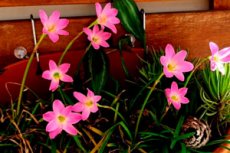
Zephyranthes is a genus of perennial bulbous plants in the Amaryllidaceae family. These plants are valued for their ornamental appeal and delicate funnel-shaped flowers. Zephyranthes are found in indoor horticulture and garden collections, delighting owners with their vibrant colors and relatively simple care requirements.
Etymology of the name
The name Zephyranthes comes from two Greek words: Zephyros (the Zephyr, a warm western wind) and anthos (flower). This reflects the plant’s ability to bloom in warm, mild conditions, as if it has “caught” the breeze of the gentle Zephyr. In some sources, Zephyranthes is also called the "rain flower" due to its blooming often coinciding with seasonal rains in its natural habitats.
Life form
Zephyranthes is a bulbous perennial plant. The bulb serves as a storage organ where the plant stores nutrients. It is due to the bulb that Zephyranthes can survive adverse conditions (droughts, temperature fluctuations) and resume growth when favorable conditions return.
Another feature of Zephyranthes’ life form is its ability to enter a dormant period. During this time, the plant sheds its leaves or slows its growth significantly. With proper care and adequate temperature and humidity, it will emerge from dormancy and bloom again.
Family
Zephyranthes belongs to the Amaryllidaceae family. This family includes mostly bulbous plants, which are often valued for their large and striking flowers. A characteristic feature of the Amaryllidaceae family is the bulb, which serves as a nutrient and water storage organ, allowing the plants to adapt to various climatic conditions.
In many cultures, Amaryllidaceae plants are valued for their beauty and are used for decorative purposes. This family includes narcissus, hippeastrums, and clivias. Zephyranthes, as a member of this family, possesses all the characteristic features of bulbous plants and provides owners with extraordinary flowering displays.
Botanical characteristics
Zephyranthes has a round or slightly elongated bulb. From the bulb, linear, narrow leaves grow, ranging from 10 to 30 cm in length. The flowers are typically solitary, funnel-shaped, and are located on a flower stalk that can reach 15-20 cm in height. Flower colors vary: white, pink, yellow, and even orange shades are common. Each flower is generally short-lived (2-3 days), but the abundant flowering creates a continuous decorative effect.
Chemical composition
The bulbs and other parts of Zephyranthes may contain various alkaloids and biologically active compounds characteristic of the Amaryllidaceae family. The exact composition of substances depends on the species and growing conditions. Some researchers note the presence of alkaloids in the plants that have pharmacological effects, but their concentration is low.
Origin
Zephyranthes originates from regions of the New World, specifically Central and South America. There, it grows in areas with a warm climate and periodic rains. In its natural habitat, Zephyranthes is often found in meadows, forest edges, and along riverbanks, where it forms picturesque carpets of flowering plants.
During the colonization of the Americas, Zephyranthes was introduced to Europe, where it quickly gained popularity due to its hardiness and decorative value. Today, these plants are cultivated worldwide, both indoors and in gardens in regions with mild climates.
Ease of growing
Zephyranthes is considered one of the easiest bulbous plants to grow indoors. It does not require complex care or special devices to maintain specific humidity or temperature. The main requirement is to provide the plant with sufficient light and moderate watering without over-watering.
Many gardeners appreciate Zephyranthes for its ability to forgive care mistakes. It can survive short periods of drought and occasionally even over-watering, as long as the other conditions are suitable. However, optimal results are achieved by following basic recommendations for watering, lighting, and feeding.
Species and varieties
The genus Zephyranthes includes several dozen species and varieties, differing in flower color, bulb shape, and size. The most common species include:
- Zephyranthes candida: White flowers, widely known as "white rain lily."
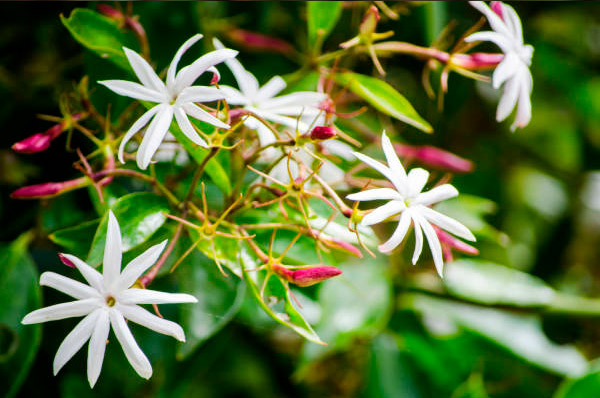
- Zephyranthes carinata (syn. Z. Grandiflora): Pink flowers, large and vibrant.
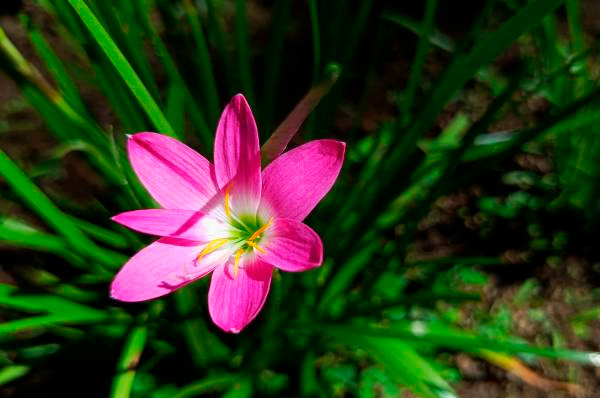
- Zephyranthes citrina: Yellow flowers resembling small lilies of a sunny shade.
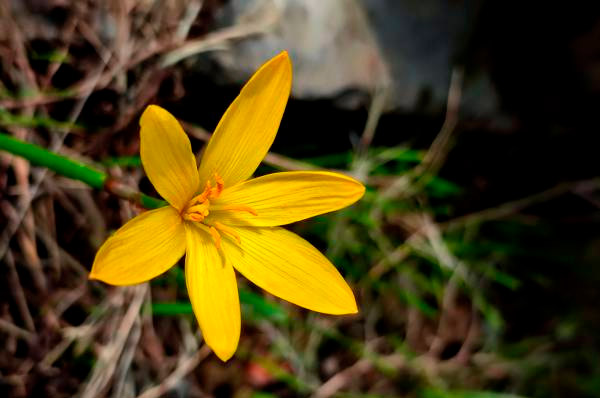
- Zephyranthes minuta: Very small flowers, but abundant blooming.
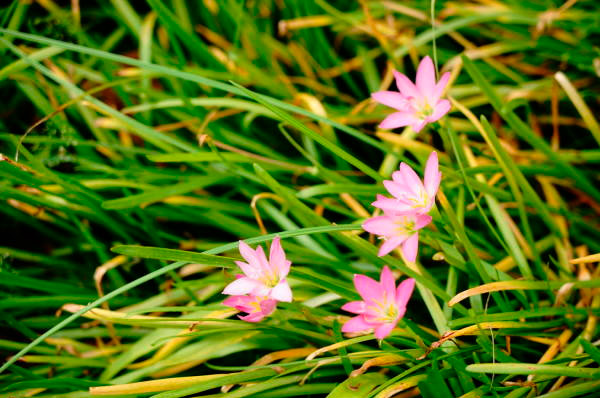
Breeders are constantly creating new varieties and hybrids, expanding the color palette and flower shape.
Size
Zephyranthes is usually compact in size. The height of the plant during the growing season, including the flower stalk, is about 15-30 cm. This makes it convenient for growing on windowsills where space is limited.
The size of the bulb typically ranges from 2 to 5 cm in diameter, depending on the species and the age of the plant. As Zephyranthes develops, it can form daughter bulbs, creating small groups that can be easily transplanted for rejuvenation or propagation.
Growth rate
The growth rate of Zephyranthes depends largely on the growing conditions. With sufficient light, moderate watering, and regular feeding, the plant can quickly increase its green mass and form new bulbs.
During active growing seasons, usually in spring and summer, Zephyranthes can produce leaf growth and form several flower stalks throughout the season. However, if conditions become less favorable (reduced lighting, lack of nutrients), growth slows, and the plant may enter a dormant state.
Life span
As a perennial bulbous plant, Zephyranthes has a rather long life cycle. With proper care and timely repotting, it can bloom and develop for many years.
Each Zephyranthes bulb can actively flower for several seasons. Over time, the bulbs split, forming daughter bulbs, which can be transplanted into separate pots or left together to form a lush bush. Thus, proper care ensures nearly unlimited plant longevity.
Temperature
Zephyranthes prefers moderately warm conditions. The optimal temperature for growth and flowering ranges from 18-24°C during the spring and summer. At higher temperatures (above 28-30°C), additional humidity and careful watering control may be needed.
During its dormant period, usually in fall and winter, the plant can withstand a temperature drop to 12-15°C without harm. This cool phase helps the bulb recover and accumulate resources for future blooming. However, sharp temperature fluctuations and drafts should be avoided.
Humidity
Zephyranthes is generally adapted to relatively dry indoor air and does not require extremely high humidity. However, during dry air conditions (especially in the heating season), it may be more comfortable with periodic misting of its leaves.
The optimal humidity for Zephyranthes ranges from 40-60%. If the humidity is too low, the leaf tips may dry out, and with excessive humidity (above 70-80%), the risk of fungal diseases increases. Regular monitoring of the microclimate will help ensure the plant receives the proper conditions.
Lighting and placement in the room
Zephyranthes prefers bright but diffused light. The ideal placement is on an east or west windowsill, where the plant receives plenty of light but is not exposed to direct midday sun, which can burn its leaves.
If natural light is insufficient, Zephyranthes may slow its growth and fail to bloom. In such cases, artificial lighting sources (grow lights) can be used to extend the daylight hours and provide the plant with comfortable conditions. It is important to rotate the pot regularly so that the leaves and flower stalks develop evenly.
Soil and substrate
For Zephyranthes, it is recommended to use fertile, light, and well-drained substrate. The optimal soil mix composition may be as follows:
- Sod soil – 2 parts
- Leaf soil – 1 part
- Peat – 1 part
- Sand or perlite – 1 part
This mix provides sufficient air permeability and retains moisture. The recommended soil pH (acidity) is between 5.5-6.5.
Drainage plays an important role in preventing water stagnation and bulb rot. A 2-3 cm layer of expanded clay or gravel should be placed at the bottom of the pot to allow water to drain freely and provide favorable conditions for root growth.
Watering
During the warm period (spring and summer), when the plant is actively growing and blooming, watering should be regular but moderate. The soil should remain slightly moist, but water stagnation should be avoided. Wait for the top layer of the substrate to dry out before watering again.
In winter, when Zephyranthes enters dormancy, watering should be significantly reduced. It is sufficient to maintain minimal soil moisture to prevent the bulb from drying out. Excessive watering in winter can lead to bulb rot and plant death.
Fertilizing and feeding
For active growth and abundant blooming, Zephyranthes requires regular fertilization. Use complex mineral fertilizers or special fertilizers for bulbous and flowering plants. Fertilizers should be applied every 2-3 weeks during the active growth period (spring-summer).
Fertilizer application methods can include watering with a solution or surface application of granules, which are incorporated into the top layer of soil. It is important to follow the manufacturer's instructions and not exceed the recommended dosage to avoid root burns and overfeeding.
Flowering
Zephyranthes flowering is one of the most attractive stages in its development. On a flower stalk, which is about 15-20 cm tall, a delicate funnel-shaped flower forms. The color can range from white and pink to yellow and orange, depending on the species.
Each flower lasts only 2-3 days, but the plant forms several buds, allowing you to enjoy flowering for a longer period. Under favorable conditions, flowering can repeat several times during the season, especially with regular watering and fertilization.
Propagation
Zephyranthes is typically propagated in spring, when active growth begins. The most common method is by dividing the daughter bulbs that form around the mother bulb. These offsets are carefully separated and planted in separate pots.
For some species, seed propagation is possible, but this method requires more care and yields slower results. Cuttings are not typical for Zephyranthes, as the bulb is the main organ for reproduction. When growing from seeds, it is important to provide the seedlings with sufficient heat and humidity, but the young plants may not bloom for several years.
Seasonal features
Zephyranthes has clearly defined periods of active growth (spring-summer) and dormancy (fall-winter). During the warm period, the plant rapidly produces leaves and flower stalks. During cooler times or when light is insufficient, it goes dormant, shedding leaves or slowing growth.
To maintain decorative value year-round, it is important to account for Zephyranthes’ seasonal growth features. During dormancy, reduce watering and lower the temperature, and in spring, gradually increase lighting, temperature, and watering frequency.
Care features
Zephyranthes is relatively easy to care for. Key points include:
- Sufficient lighting: If there is insufficient light, the plant will not bloom well.
- Moderate watering: Avoid both under-watering and water stagnation.
- Regular feeding: Apply fertilizer during the active growth period to maintain the beauty of the flowers.
- Dormancy period: Allow the plant to rest in the fall and winter by reducing watering and lowering the temperature.
It is also recommended to periodically check the leaves and bulb for diseases or pests. If any issues are detected, take timely action—prune damaged parts, treat with insecticides or fungicides, and, if necessary, repot the plant.
Care at home
When growing Zephyranthes indoors, it is important to provide bright, diffused light. The ideal place is a windowsill with plenty of sunlight, but direct midday sun should be avoided as it can cause leaf burns. Using curtains or blinds to soften the intensity of the light is recommended.
Watering should be done moderately: the top layer of the substrate should dry slightly before the next watering. In summer, during the active growing season, water the plant more frequently, adjusting to weather conditions. In winter, when Zephyranthes is in dormancy, watering should be significantly reduced.
Regular misting of the leaves helps maintain the appropriate humidity, especially during the heating season when indoor air becomes dry. However, do not overdo it to avoid fungal diseases.
Feed the plant every 2-3 weeks during the spring-summer period, alternating between organic and mineral fertilizers. Fertilizers for bulbous or flowering plants are ideal for maintaining the beauty of the flowers and encouraging repeat blooming.
Repotting
Choosing the right pot is crucial. The pot should be 2-3 cm wider than the previous one, providing enough space for the bulb to grow and have drainage holes. Pot material can vary: clay ensures better aeration, while plastic is lighter and easier to maintain.
Zephyranthes is typically repotted at the end of winter or early spring, before active growth begins. If the plant is healthy and growing actively, repotting can be done every 2-3 years. When repotting, carefully remove the bulb from the old substrate, clean off dead roots, and plant in fresh soil mix as described above.
Pruning and crown formation
Zephyranthes usually does not require special pruning since it does not have a voluminous above-ground part with branches. However, it is recommended to remove dried or yellowed leaves and flower stalks to maintain a decorative appearance and prevent the development of pathogens.
Crown formation in the classic sense is not relevant for Zephyranthes. If desired, you can carefully remove dead leaves, which improves the appearance of the plant. This will help the plant conserve resources and more effectively use the nutrients it receives.
Potential problems and solutions
The main problems for Zephyranthes are diseases (fungal and bacterial) and nutrient deficiencies. In case of fungal diseases (gray mold, root rot), treat the plant with fungicides and adjust care conditions (reduce watering, improve drainage). Nutrient deficiencies manifest as yellowing leaves, weak growth, and lack of flowering. The solution is regular feeding with complex fertilizers.
Care mistakes include over-watering the soil, leading to bulb rot, and lack of light, which hinders flowering. Correct the situation by adjusting the watering regime and moving the plant to a brighter spot or providing additional artificial lighting.
Pests
Zephyranthes can be attacked by common indoor plant pests: spider mites, thrips, mealybugs, and aphids. Preventive measures include regular inspections and maintaining clean leaves through misting.
If pests are found, use insecticides or acaricides (for mites), following the manufacturer's instructions for dosage and treatment frequency. For minor infestations, organic methods are acceptable: soap-alcohol solutions, onion or garlic infusions, and other natural remedies.
Air purification
Like many indoor plants, Zephyranthes can contribute to air purification by releasing oxygen and absorbing carbon dioxide. While its contribution is not as large as that of large-leaved plants, it still helps create a healthier indoor climate.
Zephyranthes releases phytoncides and other biologically active compounds, which, in small concentrations, can positively affect the room's atmosphere. Combined with other plants, it helps create a favorable ecological environment.
Safety
Most species of Zephyranthes are not considered toxic, but contact with the sap may cause slight irritation to mucous membranes. It is recommended to handle the plant with gloves, especially if you are prone to allergic reactions.
Overall, Zephyranthes is not a serious toxin risk for humans or pets, but it is advisable to keep the plant out of the reach of children and animals to prevent accidental ingestion of the bulb or leaves.
Wintering
During wintering, Zephyranthes slows down its growth and may shed some of its leaves. It is best to lower the temperature to 12-15°C, reduce watering, and avoid feeding the plant during this time. This will allow the bulb to recover and accumulate resources.
Before spring arrives, gradually raise the temperature and increase watering. Fertilizers are applied after the plant comes out of dormancy when new leaves begin to appear. This regime promotes active growth and abundant blooming in the new season.
Beneficial properties
In addition to its ornamental value, Zephyranthes may have some beneficial properties. Its bulbs contain biologically active substances, which, according to some studies, may exhibit antioxidant and anti-inflammatory properties.
It has also been noted that Zephyranthes as an indoor plant contributes to psycho-emotional well-being. Its delicate flowers create a sense of coziness and calm, which positively affects the mood of the owners.
Use in traditional medicine or folk recipes
In some traditional medical practices, extracts from the leaves or bulbs of Zephyranthes are used for treating inflammation, speeding up wound healing, or strengthening immunity. However, scientific data on these properties is limited, and they are not officially recognized by mainstream medicine.
Before using Zephyranthes for medicinal purposes, it is recommended to consult a doctor or phytotherapist. Self-preparing infusions and decoctions may be unsafe, especially if the dosages or preparation methods are incorrect.
Use in landscape design
In regions with a mild climate, Zephyranthes can be planted outdoors, where it decorates gardens with its bright flowers. Its compact size makes it ideal for flower borders, rock gardens, and mixed borders. Zephyranthes is often used in combination with other bulbous plants to create decorative compositions.
Vertical gardens and hanging compositions can also include Zephyranthes, especially when provided with adequate watering and lighting. Cascading plantings create the illusion of a “flowering waterfall” and attract attention from garden visitors.
Compatibility with other plants
Zephyranthes pairs well with other bulbous plants (narcissus, tulips, crocuses) as well as many ornamental foliage plants, such as chlorophytum or fittonia. The important condition is similarity in light and watering requirements.
Combining it with plants that have larger leaves or more abundant flowering can emphasize the elegance of Zephyranthes flowers. However, care should be taken that taller neighbors do not shade it too much and deprive it of light and moisture.
Conclusion
Zephyranthes (Zephyranthes) is an elegant bulbous plant known for its hardiness and ability to surprise owners with frequent bursts of flowering. Its cozy compactness and variety of flower colors make Zephyranthes a great choice for both indoor growing and decorative garden design.
A careful balance of moderate watering, bright lighting, and timely feeding helps maintain Zephyranthes' health and reveals its full potential. By observing its growth characteristics and following care recommendations, you can enjoy the beauty of its delicate flowers for many years.
